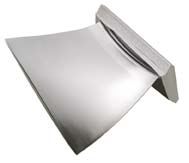On The Cusp--Faster Machining Or Finer Surfaces?
According to developers, the main feature of this new milling method is the ability to calculate a cutter location that optimizes the orientation of a milling cutter on the surface to be machined.
Share





It’s all about the cusps, isn’t it? Cusps, those linear ridges running along the tool path, are the telltale surface characteristic left behind by a milling operation with a radiused cutter. In high speed machining, the height of the cusps and the distance between them reflect the strategic goals of the programmer. Likewise, cusps are key to understanding new developments in high speed milling methods such as P-Milling from StarragHeckert of Rorschach, Switzerland (U.S. offices in Laguna Hills, California, and Elgin, Illinois).
P-Milling is a patented technique that the company developed for five-axis machining centers such as its own SX, HX and STC Series of horizontal machines. According to developers, the main feature of this new milling method is the ability to calculate a cutter location that optimizes the orientation of a milling cutter on the surface to be machined. P-Milling uses a toric shaped cutter, that is, a cutter with donut-shaped geometry about its cutting edges. (As a matter of fact, this donut shape geometry is the basis for the mathematical theory underlying this method). P-Milling tilts the cutter such that it will produce the widest distance between cusps, yet maintain a preset cusp height, thus reducing machining time or improving surface finish, depending on machining parameters.
The relative orientation of the milling cutter is derived by a special algorithm in the CAM software. This algorithm calculates several axis vectors and chooses the best one based on workpiece geometry and tolerances. According to developers, the orientation of the tool is always optimally adapted to the surface, with the lead angle changing as required. This approach distinguishes P-Milling from Sturz-milling, which applies a uniform clearance angle to the five-axis cutter orientation regardless of underlying geometry. Sturz-milling itself was introduced to North America in the 1980s by StarragHeckert (known then as Rigid Machine Tool in the United States), the company says, indicating its long experience with software for innovative milling techniques.
The company sees several values to this milling method. It serves as an effective roughing technique when applied to that task. When applied to finish machining, P-Milling either can reduce machining time to achieve the same surface quality as that obtainable with Sturz-milling, or it can use the same machining time to obtain a much better surface quality. Taking advantage of maximum width between cusps shortens milling time by reducing the number of required machining passes. In contrast, taking the same number of machining passes but minimizing cusp height reduces or eliminates hand polishing and preserves as-machined geometry.
The company cites the example of a turbine blade, where a pilot test with P-Milling showed that this method allows the five-axis machine to produce a surface finish requiring no subsequent hand polishing. It was ready to be installed in the turbine assembly without further processing.
On the other hand, a pilot test with a mold component showed that P-Milling achieved a surface in which cusps were 6 mm (0.236 inch) apart versus 0.2 mm (0.008 inch) using a 20-mm (0.787 inch) milling cutter. In this case, machining time was reduced by about 35 percent. Thus, P-milling is recommended for workpieces extensively characterized by relatively slow, unvarying curves such as molds, housings and casings.
Currently, P-Milling is an option available on any of the firm’s five-axis machines, and licenses are available for other applications. The method can be applied to any five-axis machine, although the range of motion in the cutter orientation may be limited by the configuration and clearances of the machining axes.
Read Next
Setting Up the Building Blocks for a Digital Factory
Woodward Inc. spent over a year developing an API to connect machines to its digital factory. Caron Engineering’s MiConnect has cut most of this process while also granting the shop greater access to machine information.
Read MoreBuilding Out a Foundation for Student Machinists
Autodesk and Haas have teamed up to produce an introductory course for students that covers the basics of CAD, CAM and CNC while providing them with a portfolio part.
Read MoreRegistration Now Open for the Precision Machining Technology Show (PMTS) 2025
The precision machining industry’s premier event returns to Cleveland, OH, April 1-3.
Read More





















.png;maxWidth=300;quality=90)










